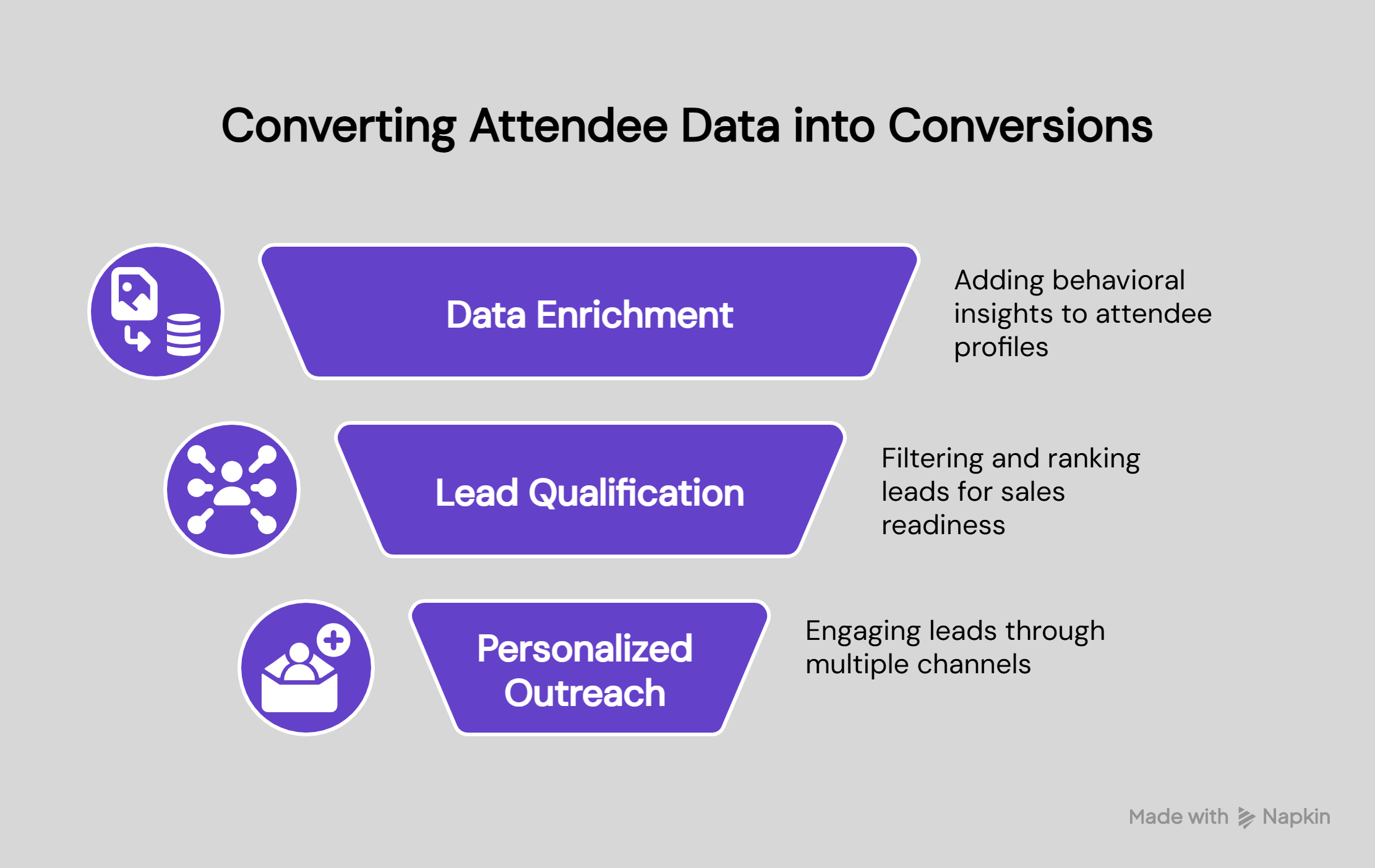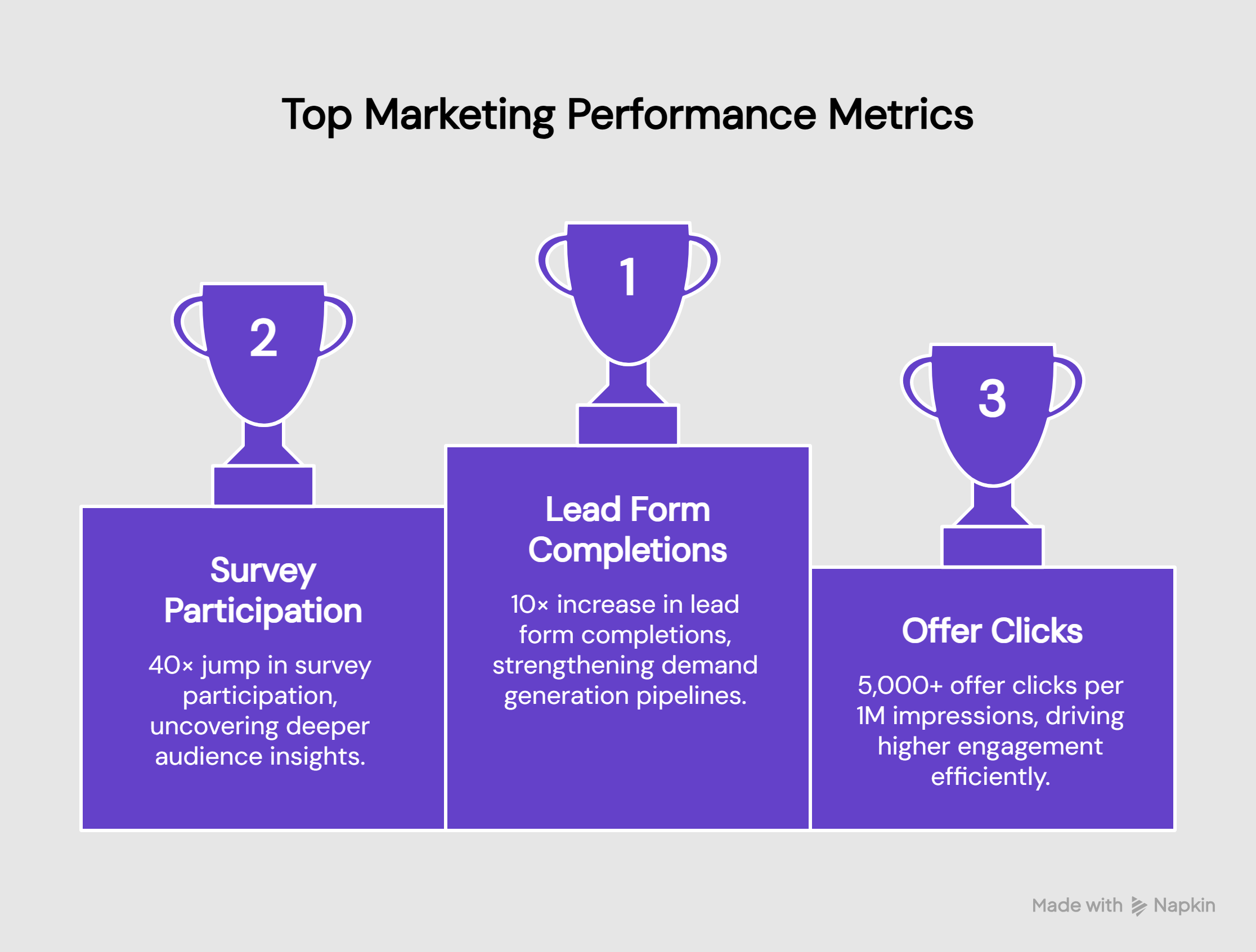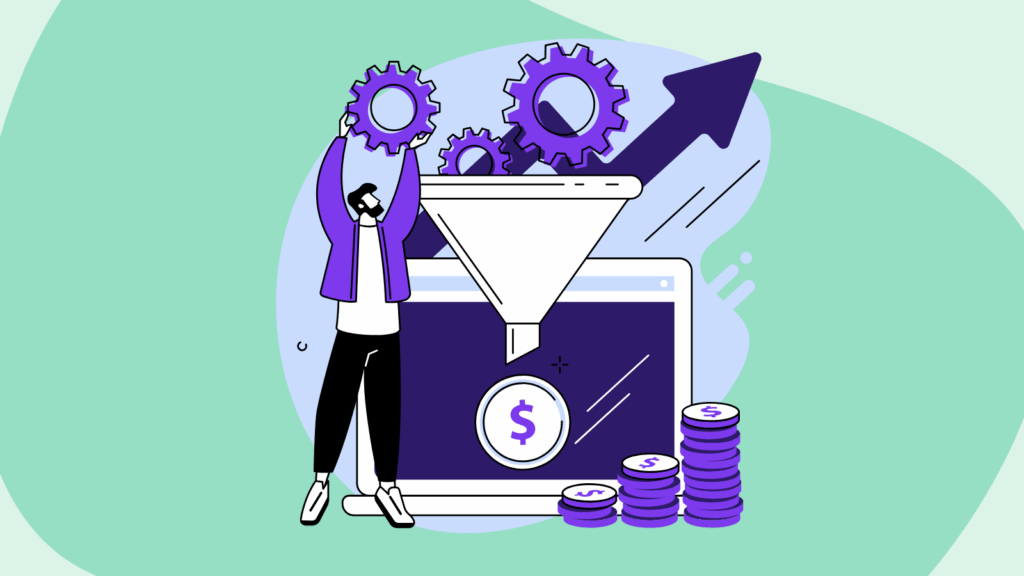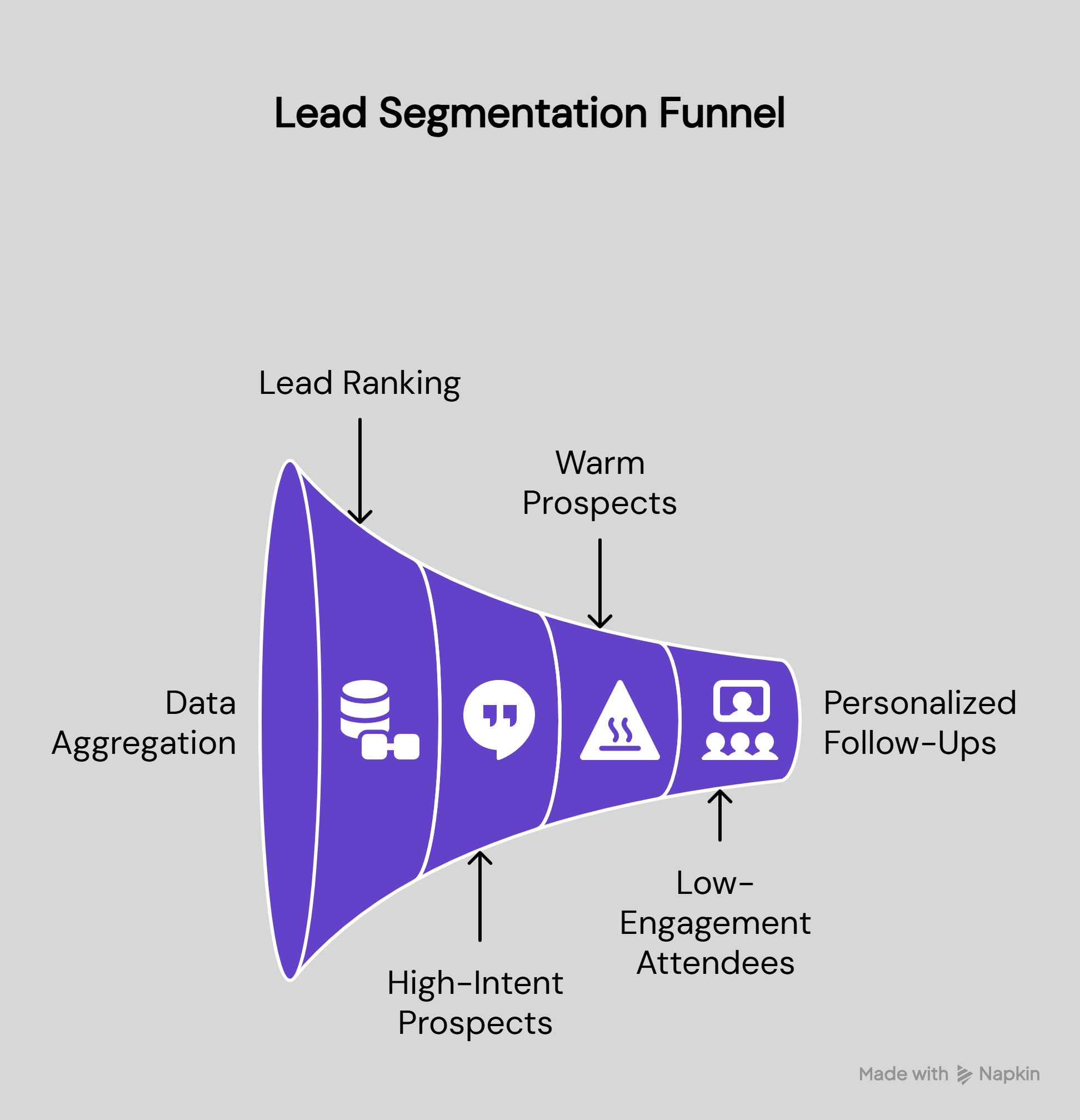By the time your last event wrapped up, your team probably had hundreds of check-ins, booth scans, and chat logs waiting to be sorted.
Each one is a clue, a small sign of what caught someone’s attention, what they skipped, and where the real interest was.
But most of those clues never get used. In fact, across many organizations, between 60% and 73% of collected data goes unused for analytics.
That’s where the real opportunity lies.
Over the past year, event teams, including our own clients, have started turning this untapped attendee intelligence into personalized outreach that feels less like marketing and more like connection. And as a result, they get higher engagement, stronger pipelines, and faster conversions.
In this post, we’ll show you how that shift happens. You’ll see how to capture richer attendee signals, qualify leads with intent, and turn them into outreach that drives measurable results.
Why Personalization Is Now a Business Necessity
That disconnect, between the signals we collect and the actions we take, is exactly why personalization matters more than ever. Audiences no longer respond to one-size-fits-all follow-ups. They’ve attended sessions, shared feedback, downloaded resources, and shown you what they care about, and they expect the next message they receive to reflect that.
The opportunity is huge. According to the B2B Marketing Report (2024), 41% of marketing leaders view events as a critical part of their demand generation strategy, while another 33% rank them among their most valuable channels. Yet only 37% of marketers measure ROI across channels, according to Nielsen’s 2024 Annual Marketing Report. That gap shows how often the potential of event data goes untapped.
A more intentional approach to personalization can close that gap. When post-event communication is tailored to what people actually engaged with, whether that’s a session topic, a poll, or a conversation, leads are nurtured faster, engagement lasts longer, and opportunities move more smoothly through the pipeline.
Many event teams are already shifting their strategies in this direction. If you’d like to see how they’re doing it, here’s a useful resource: Why 72% of event teams are turning to AI to boost engagement.
The Real Problem: Data Is Everywhere, but Insight Is Nowhere
Everyone agrees on the potential of personalization. The real challenge is execution. Events leave behind a rich trail of data, from registrations and session check-ins to downloads, polls, and chat interactions, but too much of it remains siloed across platforms, disconnected from the outreach that could turn it into results.
According to Cvent’s Mobile Event App Benchmark Report, event app adoption now averages around 63%, a number that continues to rise each year. Yet even with that growth, valuable signals such as session clicks, content views, or poll interactions are rarely used to guide follow-ups. The result is a missed opportunity: engagement happens, but it’s not converted into meaningful next steps.
The gap is clear in the data. A 2025 Remo survey found that 89% of marketing decision-makers see personalization as critical to future success, but most also admit they aren’t making full use of the attendee information they already have. That disconnect between data collection and data activation is what limits the impact of most post-event campaigns.
When all that information finally comes together in one place, patterns begin to appear. You can start to group attendees and leads based on how they showed up and interacted, whether they’re delegate prospects, SPEX (sponsor or exhibitor) prospects, or part of the audience data shared with sponsors:
Delegate prospects:
- High-intent delegates: professionals who attended multiple sessions or downloaded detailed resources.
- Warm delegates: those who interacted through chats, Q&As, or booth visits.
- Low-engagement delegates: passive participants who registered or joined but showed minimal engagement.
SPEX (Sponsor/Exhibitor) prospects:
- High-intent SPEX prospects: brands that explored sponsorship tiers, requested pricing, or attended partner meetings.
- Warm SPEX prospects: those who visited the sponsor zone, engaged with sales teams, or asked basic questions.
- Low-engagement SPEX prospects: companies that showed interest earlier (newsletter sign-ups, brochure downloads) but haven’t re-engaged yet.
Audience prospects (for SPEX sales):
- High-value prospects: delegates or companies that perfectly match a sponsor’s ICP (e.g., relevant industry, seniority).
- Warm prospects: participants who fit the target profile but showed limited engagement.
- Cold prospects: attendees outside the ICP or with little-to-no engagement, useful mainly for top-of-funnel retargeting.
Having this single, unified view of your audience becomes the foundation for every personalized follow-up that comes after.
Three Principles to Turn Attendee Data Into Conversions
Once you understand why so much valuable data goes unused, the next step is building a system that changes that. Turning raw attendee insights into measurable impact comes down to three strategic principles every event team should master. These principles work whether you’re using advanced automation or simple manual workflows.
1. Collect Rich, Actionable Signals
Most teams capture basic details like name, title, and company, but those alone won’t tell you much about intent. The real value lies in behavioural signals that reveal what people care about and how ready they are to act.
- Which sessions did they attend?
- Did they interact with polls or download resources?
- How long did they spend at a sponsor booth?
These signals offer powerful clues about interest and intent. Even something as simple as a post-session survey or content download can help you shape a more relevant next step.
2. Qualify and Prioritize Intelligently
Once you’ve collected these signals, the next step is deciding where to focus your attention. Lead scoring based on engagement depth, session topics, or content interactions ensures your follow-ups are timely and meaningful.
- Highly engaged attendees → direct offer or sales call.
- Moderately engaged leads → targeted content or nurture sequence.
- Passive participants → re-engagement campaigns to spark interest.
By ranking leads this way, you focus resources on the people most likely to convert, without wasting time on guesswork.
3. Activate Personalized Outreach Across Channels
Segmentation is just the starting point. The real results come when every follow-up feels tailored to an attendee’s unique journey. Use what you know about their behaviour to guide how and where you reach out:
- Email: Share session summaries or recommended resources tied to what they attended.
- WhatsApp or SMS: Send quick follow-ups, reminders, or exclusive offers.
- Website or Portal: Personalize the content experience when they revisit.
When each touchpoint reflects a person’s interests and actions, your outreach stops feeling like marketing and starts feeling like a conversation.

How Bridged Helps With These Three Things (Optional Accelerators)
If you’re ready to operationalize the playbook above, here’s how Bridged can support each step. These are optional accelerators; the framework works regardless of the tools you use.
1) Collect Rich, Actionable Signals → Polling Agent
- Launch lightweight polls, in-session questions, and feedback prompts without added dev work.
- Auto-capture responses, booth scans, and content interactions; standardize and route them to your CRM or data warehouse.
- Enrich attendee profiles with interests and intent signals that drive relevant follow-ups.
2) Qualify and Prioritise Intelligently → Qualification Agent
- Score attendees using engagement depth, topic affinity, and recency.
- Create sponsor-ready or sales-ready lists with transparent rules your team can edit.
- Sync prioritized segments to your CRM/marketing tools so reps start with the right names.
3) Activate Personalized Outreach Across Channels → Data Explorer Agent
- Use your agenda, session content, FAQs, and resources to power contextual replies.
- Orchestrate personalized sequences across email, WhatsApp, and your website, consistent tone, consistent context.
- Hand off to sales with conversation history and next-best actions.
What These Principles Look Like in Action: The Informa Example
These principles are already shaping how some of the most forward-thinking organizations approach their events. One of the clearest examples of how they translate into measurable impact comes from Informa.
By focusing on richer attendee signals, intelligent lead prioritization, and personalized follow-ups across multiple channels, Informa completely reshaped its post-event engagement strategy. The results speak for themselves:
- 10× increase in lead form completions, creating stronger demand generation pipelines.
- 40× jump in survey participation, uncovering deeper audience insights for more targeted outreach.
- 5,000+ offer clicks per 1M impressions, driving higher engagement without increasing ad spend.
This success was built step by step, by making personalization a part of every interaction rather than an afterthought at the end.
Want to see how they did it? Download the full case study here for a deeper look at their process, challenges, and the steps they took to scale results.

Building Your Post-Event Personalization System
Tools can help you speed things up, but the foundation of successful personalization is still a solid system. Most event teams collect great data, but where they struggle is turning that data into a system that actually moves people forward. A personalization framework isn’t a complicated piece of software. It’s just a clear process that connects what you already know about your attendees to the next step you want them to take.
Step 1: Bring Everything Into One Place
Before anything else, gather your signals. Registration info, session check-ins, booth scans, survey answers as they’re all useful, but only when they’re side by side. Most teams skip this part or do it too late. Having a single, simple view of who did what gives you the foundation to build real follow-ups.
Step 2: Sort People by How They Showed Up
Not every attendee deserves the same message. Some people were active in multiple sessions; others barely logged in. A basic scoring system, even just “high-intent,” “interested,” and “cold” is enough to know who needs what. The point isn’t perfect math; it’s to stop treating everyone like they’re at the same stage.
Step 3: Send Something That Feels Meant for Them
Once you know where people stand, talk to them like it. The most engaged group might be ready for a demo or a deeper conversation. Those who showed interest but didn’t act probably want more context, so send them guides or session highlights. And the ones who drifted away? A gentle nudge, maybe a short survey or quick offer, can bring them back.
Step 4: Let Technology Handle the Busy Work
You don’t need to automate everything, but a few well-placed triggers like a follow-up email when someone downloads content, and a message after a booth visit. All this keeps the momentum going without eating into your team’s time. The goal is consistency, not complexity.
Step 5: Keep Score and Adjust as You Go
A good system isn’t static. Track what matters: how many people are moving from leads to MQLs, how many MQLs are becoming sales-ready, and whether the quality of conversations is improving. Review these signals regularly and tweak what isn’t working. Over time, the small improvements add up to a pipeline that’s faster and stronger.
How to Measure Success From Personalized Outreach
Now, the final step is to make sure your post-event outreach is actually delivering results. To do this, track key metrics across your funnel and look for continuous improvement over time:
- SQL uplift: How many leads progress to sales-qualified status after personalized follow-ups?
- Lead quality: Are your leads more engaged and better matched to your ideal customer profile?
- Engagement rate: Are attendees interacting with post-event emails, WhatsApp messages, or content at higher rates?
- Sponsor ROI: Are sponsors seeing better click-through and meeting conversion from personalized offers?
- Operational efficiency: Has automation reduced the time your team spends on manual tasks?
Tracking these KPIs helps you understand not just what worked, but why, so you can refine your personalization strategy and improve outcomes with every event.
For more strategies on keeping event content effective long after the event ends, check out this guide on making event content more discoverable. It’s a practical next step in turning post-event engagement into long-term value.
The Takeaway
Most teams already have more than enough attendee data, the real difference comes from how you use it to start more relevant conversations. When follow-ups reflect what people actually cared about, conversations feel relevant and next steps happen naturally.
Start small: pick one event, segment attendees based on their actions, and send them messages that speak directly to those interests. You’ll see engagement rise, and with each iteration, the results will get stronger.
And if you’re ready to scale that approach across every event, Bridged can help you do it without adding complexity.
Good Reads from Bridged Media
If you have come this far, you’ll probably enjoy a few more of our reads:
- How Your Event Sales Deck Isn’t the Problem, Your Buyer Signal Is
- How to Use Interactive Content to Improve Website Engagement
- Media Event Companies are Moving Away from Display Ads. What’s replacing them?
- European Union AI Compliance Act: A Guide for Event Marketing Teams
- How Terrapinn Is Turning AI Pilots into Scaled Impact
FAQs
- How fast can this system be deployed?
Using Bridged’s 3P+ framework, event teams typically go live within 4-6 weeks, achieving measurable ROI within one quarter. - Does this replace existing CRMs or event platforms?
No. Bridged integrates seamlessly with existing tools (over 100 integrations out-of-the-box), meaning no IT sprints or platform rebuilds. - How does the Knowledge Agent differ from standard chatbots?
It’s trained on your event’s data, agenda, and content, so it gives contextual, personalized responses across web, WhatsApp, and email, not canned scripts. - How can I personalise outreach if my attendee data is incomplete?
Start with the data you do have like session attendance, poll responses, or even basic registration info. Layer it with behavioural signals like website visits or email clicks. Even partial data can power effective segmentation and more relevant follow-ups. As you collect more, your outreach will naturally become more sophisticated. - What are some common mistakes teams make when personalising post-event outreach?
The biggest mistakes are sending follow-ups too late, treating all attendees the same, and focusing too much on sales rather than value. Outreach should feel like a continuation of the event conversation like timely, relevant, and tailored to each person’s level of engagement. - How soon after an event should personalized follow-ups go out?
Ideally, within 24 to 72 hours. Engagement drops sharply if you wait longer than a week. Use automation tools to trigger follow-ups quickly based on attendee actions while the event is still fresh in their minds. - Can personalized outreach improve sponsor ROI, too?
Absolutely. When attendee data is segmented well, sponsor offers can be targeted to the right audience segments, increasing relevance and conversions. Over time, this leads to stronger sponsor satisfaction and potentially higher renewal rates.



